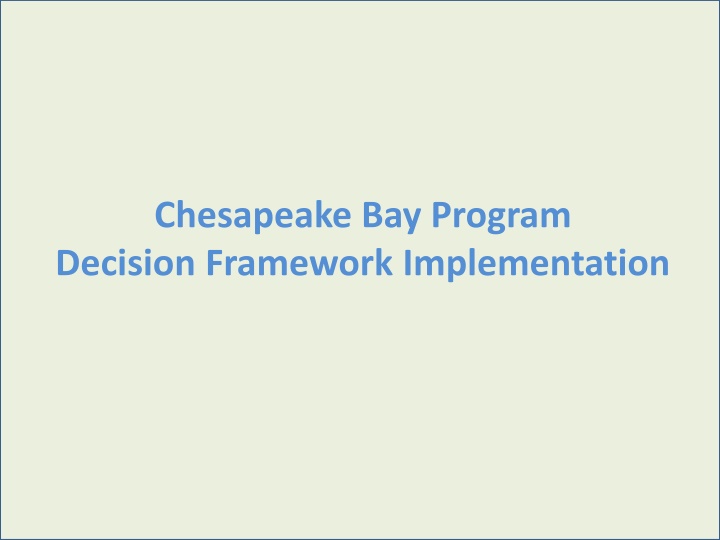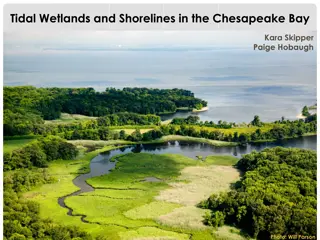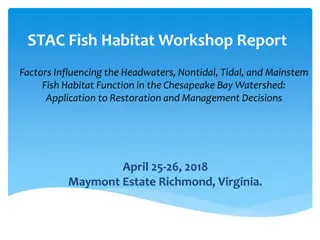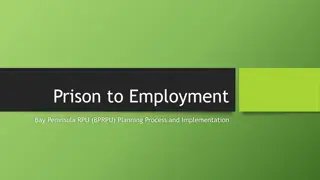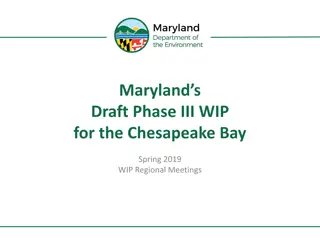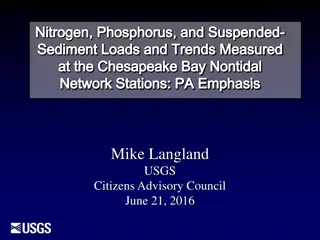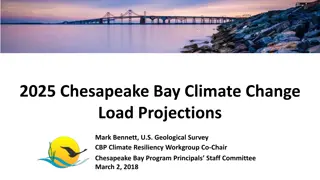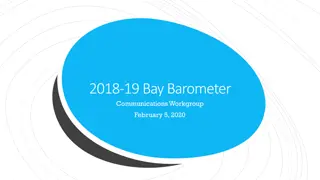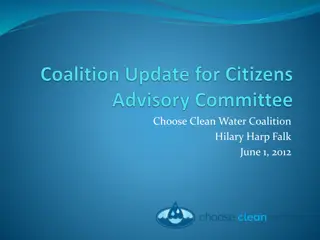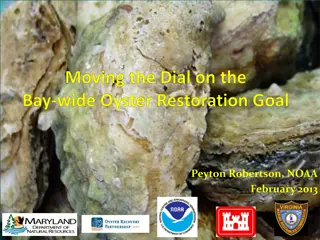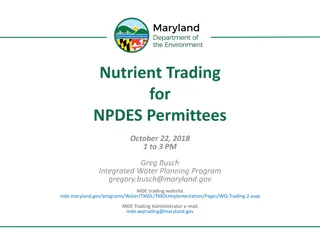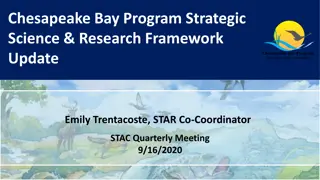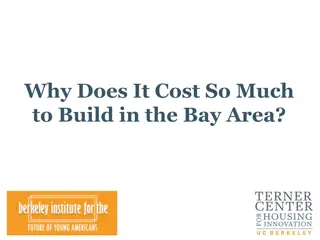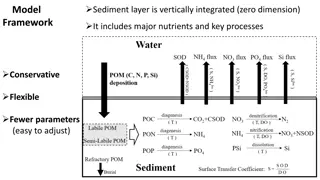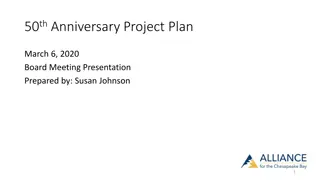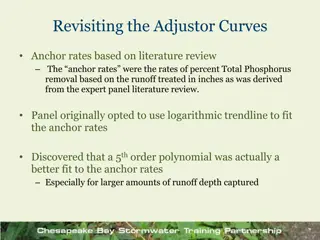Chesapeake Bay Program Decision Framework Implementation Overview
This overview provides insights into the Chesapeake Bay Program Decision Framework Implementation, including reasons for implementation, goals, steps, outcomes, and benefits. The framework emphasizes adaptive management, accountability, goal articulation, factors affecting attainment, monitoring, assessment, and adaptive management. It aims to achieve sustainable fisheries, habitat preservation, water quality improvement, healthy watersheds, stewardship, and partnerships. Through clear goals, strategies, and monitoring, the program seeks operational clarity, transparency, and enhanced coordination for effective management of Chesapeake Bay ecosystems.
Download Presentation

Please find below an Image/Link to download the presentation.
The content on the website is provided AS IS for your information and personal use only. It may not be sold, licensed, or shared on other websites without obtaining consent from the author.If you encounter any issues during the download, it is possible that the publisher has removed the file from their server.
You are allowed to download the files provided on this website for personal or commercial use, subject to the condition that they are used lawfully. All files are the property of their respective owners.
The content on the website is provided AS IS for your information and personal use only. It may not be sold, licensed, or shared on other websites without obtaining consent from the author.
E N D
Presentation Transcript
Chesapeake Bay Program Decision Framework Implementation
CBP reasons for implementing the decision framework Adaptive management Application of the logic necessary to enable adaptive management Accountability full documentation of CBP activities: what why how time-bound expectations
CBP Decision Framework 1. goals clear articulation 2. factors affecting attainment 3. current efforts and gaps 4. strategies detailed and justified 5. monitoring outputs and outcomes 6. assessment evaluate progress toward time-bound goals 7. manage adaptively short-term or long- term adjustments
Decision Framework steps GIT Goal efforts gaps manage adaptively goal factors strategy monitor assess Bay fisheries 1. Sustainable Fisheries blue crab oyster blue catfish Bay habitats fish passage 2. Habitat SAV wetlands stream Bay WQ TMDL agriculture 3. Water Quality stormwater wastewater trading forestry Bay watersheds 4. Healthy Watersheds tracking communication Bay stewardship conservation corps 5. Fostering Stewardship public access land conservation education CBP management 6. Enhancing Partnership decision framework
DF Implementation Outcomes GIT/workgroup significant effort to implement operational clarity transparency and accountability CBP management identifying coordination opportunities clarifying decision points Future program design framing management issues and partner roles
GIT/Workgroup Benefits 1. goal articulation clearer understanding of intent transparency/accountability 2. factor analysis practicality of goals identification of missed factors 3. effort/gap analysis coordination opportunities within CBP
GIT/Workgroup Benefits 4. strategy development enhanced internal and external coordination focused scope of activities 5. monitoring improved design for performance assessment coordination opportunities within CBP 6. performance assessment changed posture for future evaluations enhanced alternatives analysis 7. manage adaptively
CBP Management Benefits consistent and comprehensive documentation of program activities identification of coordination needs & opportunities across GITs strategy links monitoring coordination clarification of CBP decision points
CBP decision points GIT level strategy development strategy performance assessment and revision Program management level cross goal/strategy coordination program resource allocation needs/priorities DF implementation effectiveness Program direction level CBP scope and structure
DF Implementation Outcomes GIT/workgroup significant effort to implement operational clarity transparency and accountability CBP management identifying coordination opportunities clarifying decision points Future program design framing management issues and partner roles
Framing Future Program Design Review/synthesis of current goals EC approved goals and commitments presently there are 27 goals identified by GITs Program structure decision framework implementation is highlighting the essential distinctions between GIT purview and abilities partnership/program purview and abilities individual partners or stakeholders interests and actions
Framing Future Program Design Program evaluation What assessments are needed to monitor and manage the program? At what levels do assessments need to occur? individual intervention assessments (outputs) goal attainment evaluations (outcomes) program performance (effectiveness) Characteristics of any future agreement Should the agreement be based on: explicit environmental outcomes partnership structure governance/decision process
How do strategies and actions of one GIT influence or affect the actions and outcomes of another GIT? Decision Framework provides a common nomenclature for inter-GIT communication and collaboration In many cases geography is the common currency for inter-GIT communication and collaboration
GIT Decision Framework Coordination Water Quality GIT TMDL Goal Decision Framework Sustainable Fisheries GIT Oyster Tributary Restoration Framework Protect and Restore Habitats GIT Decision Framework(s) Articulate Program Goal Articulate Program Goal Articulate Program Goal Factors Factors Factors Influencing Goal Attainment Influencing Goal Attainment Influencing Goal Attainment Current Management Efforts Current Management Efforts Current Management Efforts Develop Management Strategy Develop Management Strategy Develop Management Strategy Develop Monitoring Program Develop Monitoring Program Develop Monitoring Program Assess Performance Assess Performance Assess Performance
GIT Decision Framework Coordination Water Quality GIT TMDL Goal Decision Framework Sustainable Fisheries GIT Oyster Tributary Restoration Framework Protect and Restore Habitats GIT Decision Framework(s) Articulate Program Goal Articulate Program Goal Articulate Program Goal Factors Factors Factors Influencing Goal Attainment Influencing Goal Attainment Influencing Goal Attainment Current Management Efforts Current Management Efforts Current Management Efforts Water Quality Standards Attainment Healthy Habitats Protected or Restored Develop Management Strategy Develop Management Strategy Develop Management Strategy Develop Monitoring Program Develop Monitoring Program Develop Monitoring Program Assess Performance Assess Performance Assess Performance
GIT Decision Framework Coordination Water Quality GIT TMDL Goal Decision Framework Sustainable Fisheries GIT Oyster Tributary Restoration Framework Protect and Restore Habitat GIT Decision Framework(s) Articulate Program Goal Articulate Program Goal Articulate Program Goal Factors Factors Factors Coordination of Management Strategies Coordination of Management Strategies Influencing Goal Attainment Influencing Goal Attainment Influencing Goal Attainment Current Management Efforts Current Management Efforts Current Management Efforts Develop Management Strategy Develop Management Strategy Develop Management Strategy Develop Monitoring Program Develop Monitoring Program Develop Monitoring Program Assess Performance Assess Performance Assess Performance
Next MB meeting: Demonstration of how the MB can use the framework to improve goal attainment by facilitating cross-goal coordination Focus: Sustainable Fisheries; Oyster Tributary Restoration (or simply living resources) Identify criteria for oyster restoration Identify gaps in GIT 1 controls (water quality standard attainment, protected/restored habitat, land use, etc. How can other GITs help achieve goals?
Oysters Goal: Restore native habitat and populations in 20 tributaries out of 35-40 candidate tributaries by 2025. Tributaries selected for restoration - based on numerous criteria, including: amount of area suitable for restoration, historic data, depth of beds, bottom type, salinity, benthic habitat, etc.
The framework helps us look across GITs for factors affecting a particular goal, but how would/should we align our restoration and protection strategies to achieve multiple ecological benefits? One approach is to begin with an assessment of various geographic priorities and strategies already in place and evaluate how well they complement each other (or not) ChesapeakeStat will help guide and visualize the process
Types of Questions That Can Be Explored Geographically What is the water quality like in a particular tributary of interest? Are the trends in DO improving or getting worse? Is the area of interest in a high nutrient loading segment? What do the WIPs say about plans for nutrient reduction for the tributary targeted for oyster restoration? Will the priority funding areas for pollution reduction activities benefit those areas targeted for oyster restoration? Is the area vulnerable to population growth and are there lands targeted for protection?
Criteria outside GIT 1 Purview We know from the Decision Framework that one of the major obstacles or factors affecting Goal attainment, is poor water quality. Segments meeting WQ standards that support living resources can help identify/narrow those tributaries with potential for restoration
Long-term trends for DO is another factor we might want to consider when making multi-year restoration investments In other words, are we selecting tributaries where water quality is getting better or worse?
One place to start is the TMDL and the pollutant load allocations already in place; and their implications for various sectors and partner programs aimed at addressing the pollution diet The Bay Tracking and Accounting System in ChesapeakeStat provides a graphic summary of the geographic implications of the TMDL
Focus on a candidate restoration area Talbot County as example. A quick look at the TMDL tracking tool in ChesapeakeStat shows that agriculture is the predominant source sector contributing to poor water quality in the Lower Choptank segment
Diving into source sectors Other data sources help explain specific contributions to poor water Example USGS SPARROW models break out nutrient and sediment loads by source sector This can help to point out particularly problematic or high loading areas (or more suitable areas).
Priority Watersheds Geographic priorities help compliment or contrast with potentially important tributaries for restoration Can be used to inform: implementation of agricultural BMPs (using the new SPARROW model) various funding mechanisms - NFWF grant prioritization - NRCS established priorities in the CB Watershed Initiative for farm bill funding
Land Use Changes Visualize realities of the changing landscape Population projections Loss of forest and farmland Urbanization and their effects: N, P & S loads viability of terrestrial and aquatic habitats Maryland s targeted terrestrial ecological areas and the degree of protection, GITs 1 and 2 may find tributaries that are priorities to multiple partners
These are examples of looking at the candidate tributaries through a regional lens to identify opportunities for collaboration and integrated planning across multiple GITs When planning on a tributary by tributary basis, additional project level information could come into play, or local monitoring information. Using these regional screens as a starting point, the Oyster team could bring other GITs into tributary specific planning for habitat restoration planning and management strategy development.
